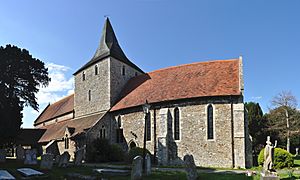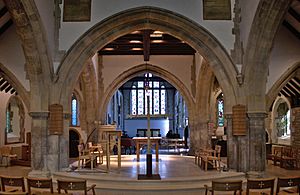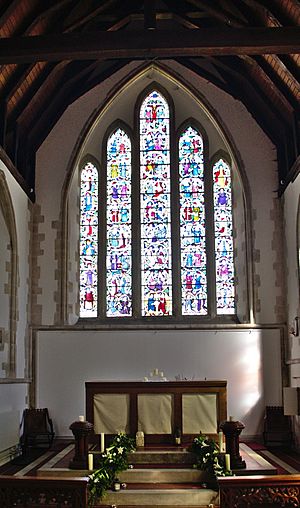St Mary's Church, Hayling Island facts for kids
Quick facts for kids St Mary's Church, Hayling Island |
|
|---|---|
 |
|
| Denomination | Church of England |
| Website | http://www.haylinganglicans.co.uk/stmary/index.html |
| History | |
| Dedication | St Mary |
| Administration | |
| Parish | Portsmouth |
St Mary's Church is a special church on Hayling Island in Hampshire, England. It is part of the Church of England.
A Look Back in Time
St Mary's Church was mostly built in the early 1200s. It was made from stone brought in from other places. In the 1400s, a wooden porch was added. Later, in the mid-to-late 1800s, the inside of the church was greatly changed and repaired. This period is known as the Victorian era. St Mary's became the main church on Hayling Island after another church, a priory church, was lost to floods in the 1200s or 1300s.
Amazing Churchyard Features
The churchyard of St Mary's has some very interesting things to see. One of the most noticeable is a huge, old yew tree. Many people believe it is one of the oldest trees in the country! Its trunk is about nine meters around. Experts think it could be anywhere from over a thousand to nearly two thousand years old.
You can also find four old sundials carved into the outside walls of the church. These were used long ago to tell time for church services, before clocks were common. Today, the big yew trees block too much sun, so the sundials don't work anymore.
In 1803, the three bells in the church tower were replaced. The old bells had the year "1324" carved into them.
Inside the Church
Inside St Mary's, there are more cool things to discover. One is a beautiful stained glass window that shows the Tree of Jesse. This is a picture of Jesus's family tree.
The church also has two interesting fonts, which are basins used for baptisms. One font is a very old stone basin from the Saxon period. It has cool patterns woven into its design. This font was found near the vicarage in the 1800s. The second font is from the Norman period. It is more square and has a simpler design.
In 2010, the church was updated. The old wooden pews were taken out and replaced with chairs. This made the church feel brighter and more flexible for different events. During these changes, workers fixed the bottom of some pillars that had been damaged by the old pews. As a fun detail, the stonemasons carved the head of an elephant at the base of one of the repaired pillars! The church's pipe organ, which had been damaged, was also replaced with a new digital organ.



